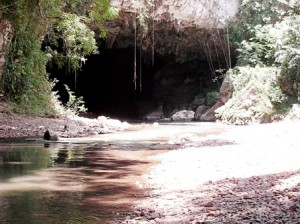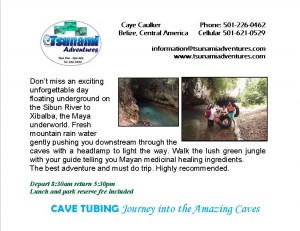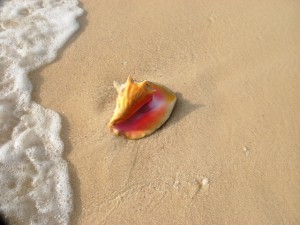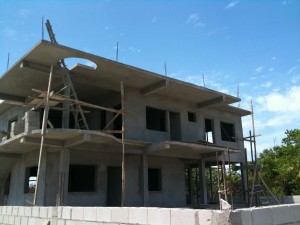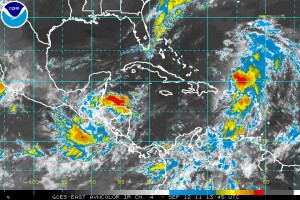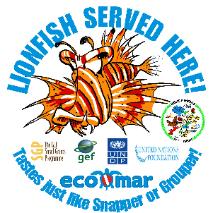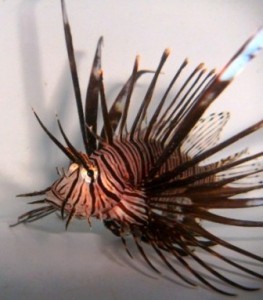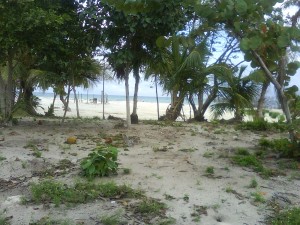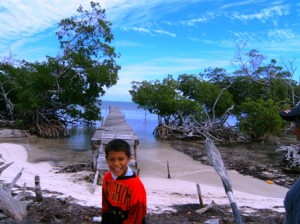Belize Caves
Thinking about Cave Tubing in Belize?
Ever wonder how those Caves where formed?
Here is an article written by Dr. Jaime Awe.
The Belize Caves Branch Cave is one of several subterranean sites that were carved out of the limestone foothills of the Maya Mountains by the very active Caves Branch River.
Belize is unique in that it has the largest cave system in Central America and the Belize Cave’s Branch is part of this natural wonder – most as yet unexplored or mapped.
The site provides us with an excellent example of the erosive power of water, and the natural wonders of Belize.
Geological research informs us that the cave took several hundred thousand years to form.
Archaeological investigations note that the ancient Maya visited the site to conduct important rituals.
Today’s modern visitor enjoys a unique opportunity to observe the awesome geological features of the site, and to ponder the nature of prehistoric human utilization.
Millions of years ago, most of the landmass of Belize was covered by a broad, shallow tropical sea. One of the major rock types deposited in this sea was limestone, a rock formed of calcium carbonate. This limestone can have its origin either from biological materials like corals and mollusks, or in some cases the limestone can be precipitated directly from the seawater.
Like the modern Gulf of Mexico, this shallow Cretaceous sea was occasionally subject to violent storms that disturbed the floor of the sea. These storms created a distinctive type of limestone rock called a breccia. Breccia is a rock that is made up of angular pieces of other rocks. In the case of the rock at Caves Branch Cave, the angular pieces of rock are called “rip up clasts.” These are pieces of rock several inches on a side that were torn up and jumbled about before the clasts or pieces had a chance to harden.
The distinctive rock is very easy to dissolve. Almost all limestone is soluble in a dilute solution of carbonic acid. Millions of years later, these Cretaceous limestones were uplifted on the northern flanks of the Maya Mountains. The central core of the Maya Mountains is formed of older crystalline volcanic and metamorphic rocks. After these mountains were uplifted, water would run off the crystalline rocks, and come into the outcrop of the Cretaceous limestones.
As the rainwater fell through the atmosphere, it would react with carbon dioxide in the atmosphere. After the rain fell into the soil on the crest of the Maya Mountains, the water would absorb additional carbon dioxide from decaying plant material. The rainwater turns into a weak acid, which then reacts with the limestone rock.
The acidic rainwater enters the limestone rock, and travels along zones of weakness called joints. Joints are microscopic cracks in the rock that are produced by mountain building processes (tectonics) and by earth tides (similar to oceanic tides). Water finds it easier to dissolve into the limestone than to flow across the limestone outcrop.
This process of solution produces a distinctive type of landscape characterized by caves, sinkholes, and a lack of surface drainage. This landscape is called a Karst landscape, named for a region in former Yugoslavia. These processes of solution are accelerated in a tropical climate, so Belize is an example of a tropical Karst environment.
Karst landscapes evolve through various stages which can be called Youth, Middle Age, and Old Age. Caves Branch is a part of an Old Age Karst landscape. One of the distinctive features of an old age landscape is a feature called a Karst window. As caves come to intersect with the land surface, they begin to collapse. This means that caves gradually lose their roofs. An underground river like the Sibun or Caves Branch will run intermittently through caves and above ground. Eventually, the caves will completely collapse, and the caves will be replaced by a valley without a roof.
Belize’s Caves Branch Caves have a series of four cave passages that connect a series of Karst Windows. The caves are what are known as “sewer” passages. In places, there are large collapsed rooms, which make the cave passage size much larger. This means that the caves have a combination of water filled sewer passages, and side chambers that have their origin in collapse.
As the caves collapse and are destroyed by erosion, a single cave that was once very long becomes divided into a series of individual shorter caves. Many side passages have become separate caves like the Crystal Cave. As the cave is destroyed, nature divides it into a series of separate short caves.
The cave stream is still an active waterway. This means that in the rainy season in the summer, and the hurricane season in the fall, the cave can completely fill with water. This is evidenced by large logs which are jammed into the roof of the cave ceiling. The cave stream also carries a great deal of sand and cobble-sized gravel.
Some of this river gravel has its origin in the crystalline rocks of the central Mayan Mountains. The main component of these river gravels is from chert or silica nodules that are part of the original limestone rock.
Belize Cave’s Branch – Nohoch Che’en ReserveThese underground rivers behave much like surface streams. This means that the river channels have a meander system similar to a surface river. The length of the meander is related to the width of the river and the gradient. Meandering rivers on the surface can change their course, and create what are known as high water levels, or abandoned meanders. These are sometimes called oxbow lakes. Another feature of the river walls is scallops which are related to maximum velocity of the river.
The gradient of the river also varies, just as the gradient of a surface stream will vary. The usual cause for gradient changes is a change in the geology. There appears to be a fault under the second Karst window. This fault has a throw of about 20 feet, so the river becomes steeper on the downstream side of the fault.
As the limestone dissolves, it is redeposited in the caves as flowstone and dripstone. Caves Branch is full of stalagmites, stalactites, and other types of cave formations. The formations that are near to the water level are often redissolved during the higher water levels. This is a reminder that caves have a life of their own. The caves have a youth, they grow old, and finally they die, as they are eroded away. Caves Branch Cave is an excellent example of a mature Karst landscape, and the site reminds us that nothing, in geology or life, is forever. Help us to protect this awesome natural wonder.
Conch Season Open!!!!
Conch Season in Belize is open from Oct 1st until June 30th
Try some local flavor and enjoy a bowl of Conch Soup. Here is my recipe that I learned from Hortencia Rosado.
| Conch meat cleaned and pounded
Limes and lime juice – clean the conch with juice Veggies – plantain, carrot, potato, whole corn, squash, cabbage and onion. cut up into bit size pieces. Herbs – Cilantro and Oregano. Use the cilantro cut up on top of the soup, adds flavor, put a couple of leaves of Oregano in the soup while it is cooking. not too much, as you don’t want to over power the flavor. You can omit this, if you want. Spices – Pepper and salt. Habenero or Marie Sharps Hot sauce – dash for flavor, just like the cilantro. Coconut oil – fry the conch in the oil and put aside. Water for Chicken soup base (maggie soup) or bouillon cubes |
|
| Instructions: | |
| Pound the conch with meat pounder and cut into bite pieces. Let Conch sit in fresh water with lime. Fry the conch in coconut oil and set aside.
Cut veggies into big bite size pieces. Cut corn 1/2 inch on cob. Slice the squash like orange pieces. Cut potatoes into square pieces. Plantain should be firm. Buy one that is yellow, if not ripe will taste bitter cut into half inch pieces add to soup last. Soup base. use oil that conch was fried in, add chopped garlic, about half a garlic head and one medium size onion. Add water and soup base. If you want your soup thick and creamy add one can of evaporated milk and one can of coconut milk. I use just coconut milk, but add this last. Sprinkle with pepper and salt to taste, be careful as maggie soup has lots of it added. Add your veggies that take longer to cook like carrots and potatos first….add cooked conch and last with plantain. Bring to a boil and reduce heat. Meanwhile make rice. If you want your rice to have a coconut flavor add coconut milk just before it is finished. About 1 cup. Serve your soup with a cup of rice. Cut up fresh cilantro along with habanero pepper and lime wedges. For more information about Queen Conch go to www.strombusgigas.com |
Building in Belize
Whether you are embarking on a small personal project like your own residence, or a large development project, the Central Building Authority is there to help you access the necessary information to make your project a reality.
Do you need to find a registered Professional Architect and/or Professional Engineer? Are you looking for a list of legislation governing the building industry? Would you like to view a list of sample forms and permitting agencies? Or do you simply need some guidance to navigate through the complex building process in Belize?
Central Building Authority is there to answer those questions and more. Contact them at 223-2616 or 223-1878. They are very helpful and will be be happy to assist you.
What They Do.
The Central Building Authority (CBA) was enabled by the Belize Building Act 2003 which is an act to control building operation in the interest of public health and safety. The CBA performs the following functions:
Plan review and no-objections to building permit applications
Site inspection
Issue permits for movable buildings
Review and provide no-objection to reports on the safety of public buildings
Inspect and recommend for demolition building unfit for use or occupation
Develop new and enforce existing building regulations
Provide guidance and information
Provide technical support for the development of policy with respect to buildings
Promote public awareness of building related issues
For more details, please contact www.cbabelize.com
What’s in a Name?
In the Atlantic Ocean, tropical storms that reach a sustained wind speed of 39 miles per hour are given a name, such as “Tropical Storm Fran”. If the storm reaches a sustained wind speed of 74 miles per hour it is called a hurricane – such as “Hurricane Fran”. So, hurricanes are not given names, tropical storms are given names, and they retain their name if they develop into a hurricane. Here are the names for 2011.
Arlene, Bret, Cindy, Don, Emily, Franklin, Gert, Harvey, Irene, Jose, Katia, Lee, Maria, Nate
Ophelia, Philippe, Rina, Sean, Tammy, Vince, Whitney
History of Atlantic Hurricane Names
Names have been given to Atlantic hurricanes for a few hundred years. People living in the Caribbean islands named storms after the saint of the day from the Roman Catholic liturgical calendar for the day on which the hurricane occurred such as “Hurricane San Felipe”. When two hurricanes struck on the same date in different years the hurricanes would be referred to by names such as “Hurricane San Felipe the first” and “Hurricane San Felipe the second”.
In the early days of meteorology in the United States storms were named with a latitude / longitude designation representing the location where the storm originated. These names were difficult to remember, difficult to communicate and subject to errors. During the Second World War military meteorologists working in the Pacific began to use women’s names for storms. That naming method made communication so easy that in 1953 it was adopted by the National Hurricane Center for use on storms originating in the Atlantic Ocean. Once this practice started, hurricane names quickly became part of common language and public awareness of hurricanes increased dramatically.
In 1978, meteorologists watching storms in the Eastern North Pacific began using men’s names for half of the storms. Meteorologists for the Atlantic ocean began using men’s names in 1979. For each year, a list of 21 names, each starting with a different letter of the alphabet was developed and arranged in alphabetical order (names beginning with the letters Q, U, X, Y and Z were not used). The first tropical storm of the year was given the name beginning with the letter “A”, the second with the letter “B” and so on through the alphabet. During even-numbered years, men’s names were given to the odd-numbered storms and during odd-numbered years, women’s names were given to odd-numbered storms.
Today, the World Meteorological Organization maintains the lists of Atlantic hurricane names. They have six lists which are reused every six years.
Retired Hurricane Names
The only change that is made to the list of Atlantic hurricane names is the occasional retirement of a name. This is done when a hurricane cause so much death and destruction that reuse of the same name would be insensitive to the people who suffered losses. When that happens the World Meteorological Organization replaces the name. For example: ” Katrina” has been retired from the name list and will not be used again.
A list of hurricane names that have been retired since the current name list system was established in 1979 is in the right column of this webpage. In addition to retirements there are a few names that were simply changed. On the 2007 list the names Dean, Felix and Noel will be replaced with Dorian, Femand and Nestor on the 2013 list.
When There Are More Than 21 Named Storms
There are normally less than 21 named tropical storms in any calendar year. In the rare years when more than 21 storms are named the additional storms are given names from the Greek alphabet: Alpha, Beta, Gamma, Delta are used for their names.
Naming Tropical Storms Outside of the Atlantic
Tropical storms occur in the Pacific Ocean and meteorologists working there have developed naming systems for them. Separate naming systems are maintained for Eastern North Pacific storms, Central North Pacific Storms, Western North Pacific Storms, the Australian Region, Fiji Region, Papua New Guinea Region, Philippine Region, Northern Indian Ocean, and Southwest Indian Ocean. The National Hurricane Center maintains lists of the names used in these areas.
Hol Chan Marine Reserve
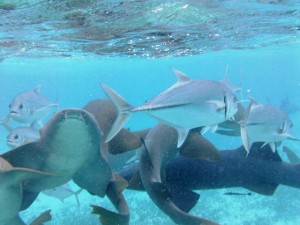 look but don't touch |
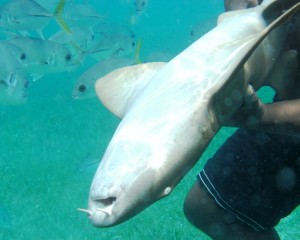 Get me outta here! |
For several years, local fishermen often cleaned their catch in this area, located just inside the reef, to the south of Ambergris Caye. When fishermen noticed that their activity had attracted Nurse Sharks and several Southern Sting Rays, they reported this information to the dive operations in San Pedro, who then dispatched some divers to investigate. What they found was a bonanza, and “Shark-Ray Alley” quickly became a very popular dive site.
This is a must stop for the first introductory dive or snorkel in Belizean waters. Zone D is only 20 minutes north of Caye Caulker by power boat. Shark Ray Alley has a maximum depth of 30 feet and excellent visibility. You can almost always see all species of fish including jacks, groupers, snappers, parrot fish, angel fish, barracuda, eels, spider crabs, lobster, and nurse sharks. Divers are occasionally cautioned regarding the currents.
As soon as your boat arrives in the area, you will notice a number of dark shadows in the shallow (eight foot deep) waters. These are the sharks and rays that hear the boat approach and come in search of a few scraps of fish.
These creatures have a great tolerance for divers and snorkelers and seem to enjoy the human interaction. The rays, which have a ‘wing-span’ of two to four feet, swim directly towards the snorkelers and divers, inviting them to reach out and stroke their wings (although it’s best not to touch them). The gentle Nurse Sharks average four to six feet in length. While the animals show no fear of humans and will often swim right up to snorkelers, it is best to keep a distance and not touch the animals.
At Tsunami Adventures, we are proud to offer a “no touch policy”. We respect the marine animals in their home. We do not grab them for you to pet nor do we chase after the nurse sharks and flip them over for you to caress. This action is actually equivalent to us humans gasping for air in water. Some will say they like this, however we beg to differ.
The Lionfish
You may have seen a picture of a lionfish or heard of them, but in Belize? The introduction of lionfish into the Wider Caribbean Sea is believed to have originated South Florida when several lionfish were known to have been released into the sea. The shallow tropical waters of the Bahamas has witnessed a population explosion over a period of 4 years
between 2004 and 2008. Bahamian fishermen are now harvesting lionfish for consumption since they are among
the largest fish in the sea. Don’t be surprised if you are on a tour with us and your guide attempts to kill or catch the lionfish. Lionfish are voracious predators and can consume almost 80% of juvenile fish recruits including the important
fishery export products like snappers and groupers, and parrotfish, which help keep the coral reefs clean of algae.
Lionfish are also known to eat crustaceans, like the spiny lobster. In 30 minutes a lionfish was observed eating
more than 20 fish! YIKES!!!! The local guides and fisherman have been doing a great job on the Barrier Reef and they have been on many dinner tables to enjoy.
Pterois is a genus of venomous marine fish found mostly in the Indo-Pacific, known collectively as the lionfish. Pterois is characterized by red, white and black stripes, showy pectoral fins and venomous spiky tentacles. Pterois are popular aquarium fish and are readily utilized in the culinary world.
Caye Caulker North Side
Caye Caulker is more than just one island, it’s two. The North side and the South side, referred to as Caye Caulker Village and Northside. Caye Caulker Village is where the majority of the population lives. Electricity is supplied by BEL. There is now a water system. Shops, restaurants, hotels (57) and private homes all co-habitat on this small island of .15 to 1.2 miles wide and 5 miles long. Expect telephone, cellular, internet, satelite television, 2 banks, 1 ATM, delivery services, 1 gas station and almost everything you need. 2 cemeteries and no hospital. Airstrip that services small places to reach the city and other destinations. The island is divided in two at the famous SPLIT. A very well known watering hole located at the North End of the CCV side. A great hang out for shady people as written on their designed t-shirts and sign. Spend the day here relaxing, swimming, snorkeling, have a few belikins, canoe, cross the split and walk the North Side. About 30 feet of water divides the two islands. At one time it was only a trickle of water between the two, until Hurricane Haitti eroded the area naturally and later locals decided to dredge enough space to pass boats to the back of the island. This was considered a short cut to the gas station.
Here is a map of Caye Caulker North Side. A great place for canoeing or kayaking. We rent one double kayak and one single kayak, plus we have 2 double canoes for rental at Tsunami Adventures. We also offer a 2 hour cruise around both island with a stop at the Reserve on the very North tip of Caye Caulker.
Visiting Caye Caulker’s NORTHSIDE. By foot, swim across or get a drop on the other side of the split. Walk the trail, make sure you bring water. A dozen more or less private homes, scattered along the main road spanning one mile North of the Split. There is talks of BEL extending it’s electricity service, but no movement yet! At night, there is no streetlights to light your way, so make sure you have a flashlight. Another way to visit the NORTHSIDE is by canoe or kayak, circle the island or move up North on the front side or back side of the island. Usually the breeze is blowing, so going around the back, makes for a calm relaxing paddle. Cruise along the mangroves, look for seahorses, spot eagle rays forging for food and nurse sharks nesting in the shallows of the mangroves. I like to make a pit stop at the old Driftwood Dock, a great place for a swim and relax, paddle up the lagoon entrance and into the natural lagoon that is a great place to catch sprat for fishing. This is a great location to spot crocodiles at night. We offer a crocodile night and stargazing tour starting at 7:30pm, lasting 2 hours. snacks and rum punch or non-alcoholic drinks included as well as a bright LED flashlight to search them out along with your guide in the darkness of the night. Fireflies flicker amongst the mangroves while the orion, cassiopeia and the big dipper watch over you.
Snorkeling for Free Caye Caulker
Free Snorkeling!
You wouldn’t think we would want to tell you about free snorkeling, when we have all these wonderful tours we want you to go on.
Well, we all want somethings for free. It certainly isn’t going to be as good as a one of our reef tours, however it will surely be fun and hopefully you will be able to see lots of marine life.
If you have your own snorkeling gear, then great, if you need fins, we have them for rental for only $5BZ or $2.50USD if you need the full set. Mask, Snorkel and Fins we rent all day for $5.00USD a set. If you want a week, then you pay for 5 days rental and get two days free. It’s not entirely free but a heck of a deal.
The best place to go Snorkeling for Free is at the split. I often recommend to people to start from the end of our dock and swim around there and then onwards towards the split over the Sea grass beds, where you will see sea stars and young corals. Swim down along the seagrass edge towards the split bar area, swim along the wall, tons of fish. Dive down and under the ledge there is a few nurse sharks hiding out. You may see some lobsters hiding in the cracks. Swim accross the split and snorkel through the mangroves. Lots of fish hiding out in the mangroves.
Be careful crossing the split. Look both ways twice and then swim across fairly fast and get to the side of the mangroves.
If you are a little more adventures, swim around the whole South island of Caye Caulker. Stay close to shore. We do not recommend swimming out to the reef with out a canoe or kayak and life jackets, as well as permission from the Caye Caulker Marine Reserve.
With a good eye you can spot hidden Sea Horses wrapped around the mangrove roots.
If you have plenty of energy consider renting a canoe or kayak with a friend. We have double canoes and 1 double kayak for rental at Tsunami Office for $25USD all day or $7.50USD an hour. You can paddle out to the Reef, with permission of the Caye Caulker Marine Reserve and a $10BZD per person fee. So this pretty much defeats the purpose of FREE SNORKELING….but if you need more information about this, then you now know it is available.
If you are a guest of Costa Maya Beach Cabanas, Canoes are included in your nightly rental rate. Another good reason to stay at Costa Maya Beach Cabanas. Not only do they offer FREE WIRELESS and BICYCLES. CANOES TOO!!!!
Consider snorkeling at the split at night for a totally different experience. Don’t be afraid of the dark. For only $5USD we rent underwater flashlights. But if you have your own then better, because it is FREE……
Eating on Caye Caulker for $10USD a day
There is a over 20 restaurants on Caye Caulker. All offering a little bit of the same and with a Twist of different flavors. There is not much for international food, but if you have a craving for Italian, there is two restaurants that specialize. And don’t forget there is always a Chinese restaurant or take away anywhere you go in Belize.
Here is a guide to eating good food for breakfast, lunch and dinner for only $10USD total.
You don’t have to cook anything, only wait for your food to be ready.
Breakfast
Waffles to go at Jesse’s Snacks. Choose your toppings, butter, cheese or syrup. $1.00USD. She also serves fresh made tortilla with ham, cheese and beans for $2.50USD. A very filling breakfast.
Fruit plate from Julia’s Fruit Stand or Gloria’s Deals on Wheels. Bananas, pineapple, papaya & watermelon all cut up ready to eat in a nice to go container with fork for $2.50USD
A new place in the palapa area and one of my favorite places to get a fresh made smoothie of your choice of fruits for $1.50USD. They also sell fresh made fruit juices for $5USD for one liter.
Lunch
Local Favorite and usually eating by every Belizean daily. Rice and Beans or Stew Beans and Rice with Stewed Chicken with salad and plantain. This will keep you full all day $3.50USD This meal can be purchased at Martinez just around the corner from Oceanside or purchased to go at Glenda’s located to the back by the BTL complex. I usually share this meal or save what I can’t eat for a snack later. The also do great burritos for $3USD
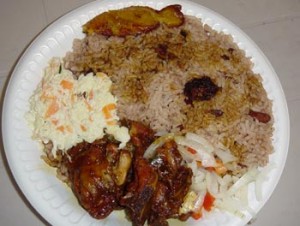
most popular meal in Belize
Dinner
Another favorite of ours is El Paso, just accross from the bakery, which is a must stop, more details below. El Paso is very inexpensive Spanish food. Very flavorful. I like their vegetarian burritos. Neno’s is stewed beef and beans served with your choice of fry jack or tortilla for only $4USD, enough for two to share. They also serve fresh and only .50 cents each. Garnaches, Salbutes, Tostados, Panadas and Fry Jack. This place serves breakfast, lunch and dinner.
Chinese Fried Chicken or Fried Rice or a cheese burger in paradise to go, at any of the local Chinese Takeaway, this meal can also be eaten in. Open for lunch and dinner.
Now, you can’t eat the same meal everyday, so here are some other inexpensive meals. The best is to take your food and find a nice place to relax on the beach and enjoy the view and breeze.
Homemade Meat Pies to go. For only $.50 cents USD each. Buy 3 and have a filling tasty meal. This are usually eaten for breakfast. He usually walks through the village with his cart and you know he is around as he hollers out Meat Pies…He also has these really good lemon tarts for the same price. His wife does all the cooking.
Tamales, Rubin is usually around every day, Tamales are always available on Saturday and Sunday in the morning and up to lunch time. They are $1.50USD each. Very tasty local dish, made with corn / masa and chicken.
Chicken King, has his home made cart that is roasting chicken as he pushes his cart through the village, you can smell it as it passes by. Chicken is sold by the 1/4 chicken for $2.50USD comes with dinner roll. He also makes chicken burgers for only $2.50USD and they are delicious.
Conch Fritters usually present themselves around 4pm, a perfect time for an afternoon snack. $.75 cents only. Lots of flavor. When in season, he has lobster fritters. He also does pizza pockets for only $.50 cents each.
Tacos in the morning. These gyals start early and offer fresh juice and tacos. A order of 3 is only .50cents.
There is currently 3 or maybe four ladies offering this early from 6am. They set up on the street side, close to the water taxi area. Fresh orange juice and tacos, a local favorite, you will often see a crowd around, all waiting for their order.
Don’t forget to pass by Mrs. Eladel of Mom’s Kitchen, she makes fresh Johnny Cakes. Have your Johnny Cakes with ham and cheese or chicken and beans, or beans and cheese.. Only $.75 cents USD each.
We don’t want to forget about all of these other wonderful places that offer great food for really good prices. Glenda’s Restaurant, she has breakfast and lunch. She is also known for her homemade cinnamon rolls for only $.50 cents USD each. Make a pitt stop at the local bakery. A great place for snacks in the afternoon. My favorite is the ham and cheese flake pastry or the hotdog in a bun. Only $1.50USD
Bones aka Llyod starts from the split and walks towards the main part of the village daily starting around 4pm and offers fresh baking of Banana Breads and other cakes and cookies.
Aldame, also known as Caye Lady makes all sort of wonderful cakes for sale for $2USD each, she starts at the opposite end and works her way to Tsunami, then is back in the evening by the palapa area. She does an awesome coconut cake.
She also makes wonderful tortillas that she sells through the local stores. $1.50USD for 5 tortillas. I loves these with fresh avocado and cheese.
Conch Soup from Aunties Fast Food. Locally made and only $5.00USD comes with rice. This is enough soup for two people or save some for dinner. She has a huge variety of take a way food on her menu.
There is so much wonderful inexpensive food in Caye Caulker that is made by locals. Offering excellent food.
There is many restaurants offering Barbecues and fine cuisine. I don’t think there is a bad restaurant in Caye Caulker.
Remember that Caye Caulker’s, moto is GO SLOW. So sit back and relax and enjoy the local cooking of Caye Caulker.
Strombus Gigas – Queen Conch
Conch Season in Belize is open from Oct 1st until June 30th
Try some local flavor and enjoy a bowl of Conch Soup.
| Conch meat cleaned and pounded
Limes and lime juice Veggies – plantain, carrot, potato, corn, squash, cabbage and onion. Herbs – Cilantro and oregano Spices – Pepper Habenero or Marie Sharps Hot sauce Coconut oil or butter Water |
|
| Instructions: | |
| Pound the conch with meat pounder and cut into bite pieces. Let Conch sit in fresh water with lime. Let sit while cutting vegetables
Cut veggies into big bite size pieces. Cut corn 1/2 inch on cob. Slice th squash like orange pieces. Cut potatoes into square pieces. Plantain should be firm. Buy one that is yellow, if not ripe will taste bitter cut into half inch pieces add to soup last. Make soup base. Heat oil, add chopped garlic, about half a garlic head and one medium size onion. Drain conch and pat dry. Add Conch to garlic and onion and brown a little. Take out conch and put aside. Add water and soup base. If you want your soup thick and creamy add one can of evaporated milk and one can of coconut milk. Sprinkle with pepper to taste. Add your veggies, carrots and potatos first….add conch. Plantain last. Bring to a boil and reduce heat. Meanwhile make rice. If you want your rice to have a coconut flavor add coconut milk just before it is finished. About 1 cup. Serve your soup with a cup of rice. Cut up fresh cilantro and oregano along with habanero pepper and lime wedges. For more information about Queen Conch go to www.strombusgigas.com |

